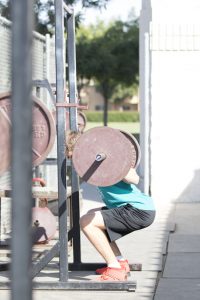Why the squat is the “king” of lifts and should rule your training program.
You squat when you sit down. When you stand up out of a chair. You do single leg squats (albeit with a short range of motion) when you walk up or down stairs. You squat when you pick something up off the floor. Before you jump and when you land after a jump. You squat when you use the… nevermind, you get the idea.
The basis of every effective strength training program, either for sports or general strength development, is the squat. If it isn’t part of yours, you need to get a new program.

The squat is a complex multi-joint movement pattern that involves flexion of the hips, knees and ankles. It maintains isometric contraction of the spine erectors and muscles in the lower legs and feet to balance the body’s mass over the middle of the foot.
After proper squat depth, sensory information received from the eyes and middle ear, followed by extension of the hips, knees and ankles against the force of gravity return the body a full standing position. Squats can be performed through a broad range of motion, from a subtle bending of the hips and knees to a full “bottom-to-heels” position.
If you search Youtube for about .6 seconds, you can find 47 million (I’m not exaggerating, that’s the actual number of search results) videos on how to squat, demonstrations , clips from competitions, weirdos (or narcissists, not sure which) doing “air squats” in public places, and so on. Those results bear witness to how important it is as a strength training movement.
Now I must emphasize that many (perhaps most) of those videos include nonsense, silliness, incorrect information, improper and perhaps even counterproductive advice. However, the fact remains that squatting is almost universally accepted as the most important exercise for improving lower body strength.
There are many types of squat– the air, partial, low bar, high bar, belt, safety bar, goblet, front, split, and jump squat, etc,–as well as multiple variations of each of those types. So, how do you pick the “right” type to use in your training? I suggest that the answer depends on several factors, including your goals, your current physical ability, your access to equipment, etc.
At the FC Barbell Club and in the FC S&C PE classes, we use the low bar back squat and a couple of its variations. This particular technique meets the three criteria for effective barbell training: use the greatest amount of muscle mass to move the greatest amount of weight through the longest effective range of motion. (For a full explanation see a previous post– “If You Want to Get Strong…”)
To perform the low bar squat, place the bar on your back in a position just below the spines of the scapulas (shoulder blades). When the bar is in position and trapped against your back by your hands, it should be directly over the middle of the foot. Set your heels about shoulder width apart and turn your toes out a little bit–30-35 degrees out from pointing straight ahead. This will help you maintain balance and get to proper depth.
Take a big breath into your lungs and hold it tight, without letting any air out during the entire repetition. Isometrically contract (squeeze) all the muscles in your torso–upper back & shoulders, mid-back, lower back and abdominal muscles–to keep your back flat in lumbar extension.

The air locked in your torso and the tight muscles will help you maintain a flat rigid spine through which you transmit force to the bar to lower it under control and raise it up against gravity.
Before you start the squat, pick a spot on the floor 4-5 feet in front of you and keep your eyes on that spot through the entire lift. This helps significantly with balance, focus and spatial orientation. To start the movement, hinge at the hips and the knees simultaneously and allow gravity to pull the bar and your torso down toward the earth. Lean forward so your chest starts to point at the floor while at the same time pushing your hips back and down.
As you descend with the bar on your back, keep yourself balanced over the middle of your foot; don’t rock forward on your toes or back on your heels. During the descent, push your knees out so they point the same direction as your toes. This will open your hips and and keep your belly, if you have one, from squishing on your upper thighs and blocking your descent.
Keep going down until the crease of you hip, that little line that forms between your upper thigh and your torso when you bend over, is just below the top of your knee cap. At this point, your chest should be pointing at the floor, your hips should be behind your heels, your knees should be more or less over your toes, and you should still be balanced over the middle of your foot. It is important to keep your back flat in full lumbar extension as you go down.
Once you get to the bottom of your squat, you must stand back up. To go up, keep your eyes on your focal point and drive your hips up into the air in a straight vertical line. Maintain your flat back and your balance over the mid-foot. As your knees and hips extend and straighten, the bar should stay over the knot of your shoelaces.
Keep pushing your knees out through the entire ascent; this allows you to use the muscles around your hips, the adductors and abductors, to help with the extension. Finish the lift with your knees and hips locked out and your back nearly vertical. Repeat this movement for the appropriate number of repetitions to complete your set.
There are several more fine points and details involved in the movement, but those are the basic elements. If you are interested in learning more about the squat, the other barbell lifts or getting stronger, feel free to contact me. Students are welcome to join the FC Barbell Club. Individual and small group coaching is also a possibility.
As I wrote at the beginning of this post, the squat is a natural and essential movement used in everyday life. Doing it with a barbell and gradually increasing the load over time will make you stronger and it will get progressively easier to perform the movement in all of its real-life applications. This doesn’t necessarily mean that real life will be easier, but you will be better equipped to handle the hard parts and will therefore be a more functional human.
To read Fuller’s latest blog: Functional Human blog, No. 11-The Gift You Give Yourself and his first blog: Functional Human blog, No. 1






